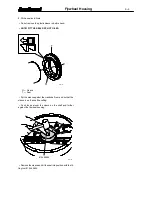
45--- 7
80 Nm
1
2
3
4
Crankshaft
5---2
D. Fitting crankshaft
1. Clean the oilways, bearing shells and bearing locations.
Check that the crankshaft is clean.
A
B
45--- 4
2. Assembly the bearing with oilholes/groove (
A
) to the cylin-
der block and the bearing with no hole (
B
) to the bearing cap.
Ensure that the bearing shell clamping claws fit into their
notches and that the shells to be fitted in the cylinder block
have a hole coinciding with the oil port.
3. Lubricate the bearing surfaces and fit the crankshaft. Fit the
crankshaft thrust bearings with the lubricating grooves facing
the crankshaft.
200 Nm
45--- 5
7
6
4. Fit the main bearing caps according to their numbering
(bearing lock in the block and in the cap are on the same
side), the rear with thrust bearings provided with guide lugs.
Lubricate the bolts and tighten them to
200 Nm
.
0,10...0,38 mm
45--- 6
5. Check that the crankshaft can rotate without binding.
Check the end float using a dial gauge. The correct end float
is
0,10... 0,38 mm
. If the end float is too large, oversize thrust
bearings should be fitted.
Note!
Bearing shells should never be reamed or machined in
any other way, nor should the sides of the bearing caps be
filed
E. Checking vibration damper
1. Housing
2. Damper mass
3. Liquid cavity
4. Bushing
In the 645---engines the crankshaft front end incorporates a
torsional vibration damper. The vibration damper consists of
a sealed housing in which there is a mass of steel. This mass
(the damper ring) is carried in the centre on a bushing and is
surrounded on all sides by a viscous silicone fluid.
Do not remove the damper by turning forcibly and be careful
not to damage it when it is loose. Even a small dent makes the
damper inoperative. If you detect a dent on the outer surface,
do not install the damper back in the engine.
Note!
(645---engines with timing mark on the damper) Vibra-
tion dampers delivered as spare parts do not have injection
timing mark. Make the marking on the new damper with an
electrical pen,
do not tap!
Piston distance from top dead centre vs. crank angle, see in-
struction
7 B
.
















































